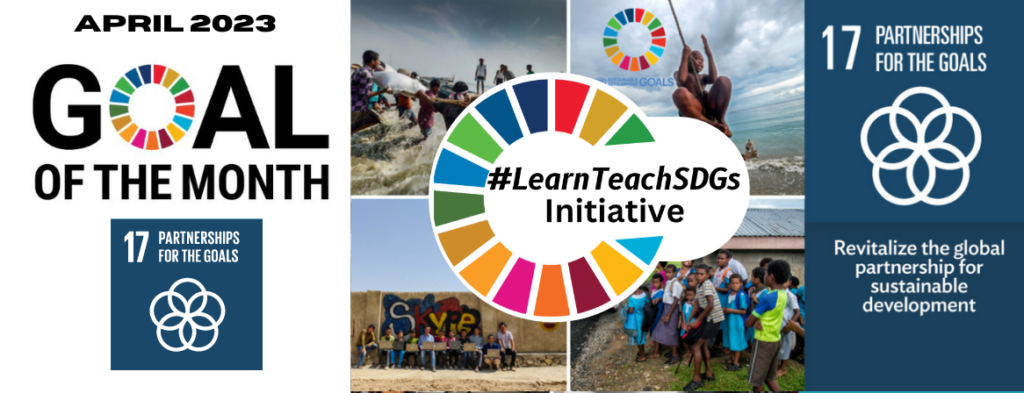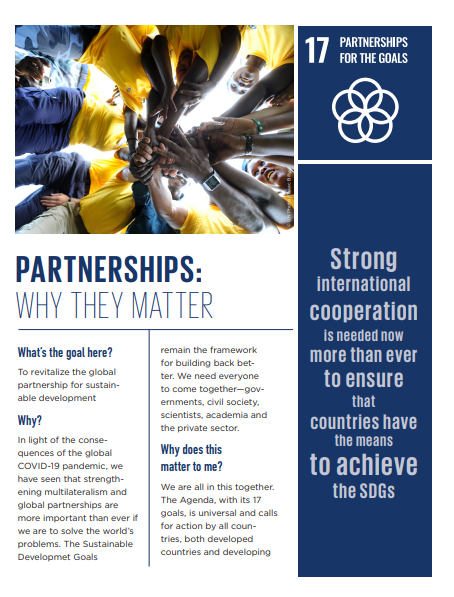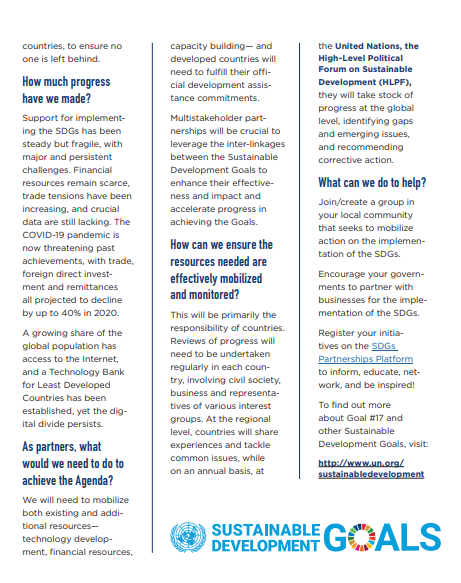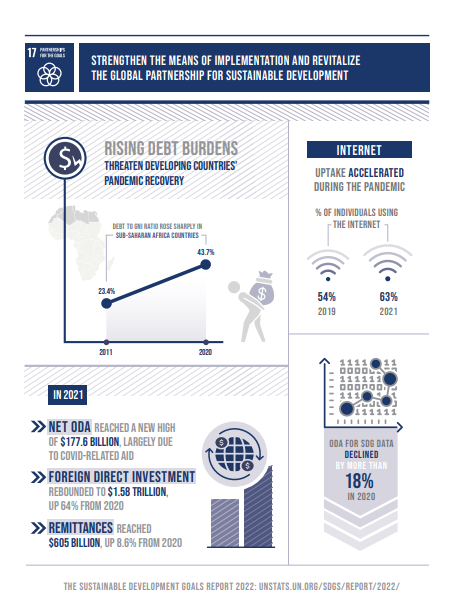
Goal 17 is about revitalizing the global partnership for sustainable development. The 2030 Agenda is universal and calls for action by all countries – developed and developing – to ensure no one is left behind. It requires partnerships between governments, the private sector, and civil society. The Sustainable Development Goals can only be realized with a strong commitment to global partnership and cooperation.
Significant challenges remain. Official development assistance (ODA) has not reached the targeted level; private investment flows are not well aligned with sustainable development; there continues to be a significant digital divide; and there are ongoing trade tensions. To be successful, everyone will need to mobilize both existing and additional resources and developed countries will need to fulfill their official development assistance commitments.

Facts and figures
*In 2021, net ODA flows amounted to $177.6 billion, an increase of 3.3 percent in real terms from 2020, representing 0.33 percent of donors’ combined gross national income (GNI). Despite hitting a new peak, it still fell short of the 0.7 percent target.
*In 2021, 150 countries and territories reported implementing a national statistical plan, up from 132 in 2020.
*ODA for data and statistics amounted to $650 million in 2020, a slight decline from $662 million in 2019. The overall trend in funding for this sector has remained stagnant at 0.3 percent of the total ODA.
*Total external debt stocks of low- and middle-income countries rose by 5.3 percent in 2020 to $8.7 trillion, driven by an increase in long-term debt, which rose by 6 percent to $6.3 trillion.
*In low-income countries, the total public and publicly guaranteed debt service to export ratio rose from 3.1 percent in 2011 to 8.8 percent in 2020.
*The number of Internet users surged by 782 million to reach 4.9 billion people in 2021 or 63 percent of the global population.
*Fixed broadband subscriptions continue to grow steadily, reaching a global average of 17 subscriptions per 100 inhabitants in 2021. In the least developed countries, fixed broadband remains a privilege of the few, with only 1.4 subscriptions per 100 inhabitants.
*Global foreign direct investment flows rebounded strongly in 2021, reaching $1.58 trillion, up 64 percent from 2020.
*Foreign direct investment flows in developing economies increased by 30 percent, to nearly $837 billion. *Flows in the least developed countries saw a more modest growth of 13 percent.
*International investment in SDG-related sectors in developing countries increased by 70 percent in 2021. Most of the growth came from renewable energy and energy-efficiency projects.
*The share of total SDG investment that went to least developed countries decreased from 19 percent in 2020 to 15 percent in 2021.
*In 2021, remittance flows to low- and middle-income countries reached $605 billion, up 8.6 percent from 2020. The cost of sending money across international borders continued to remain high, at 6.0 percent, double the 3 percent target.
*Remittance flows are projected to increase by 4.2 percent to reach $630 billion in 2022, less than half the growth seen in 2021.
Goal 17 targets
Finance
17.1 Strengthen domestic resource mobilization, including through international support to developing countries, to improve domestic capacity for tax and other revenue collection
17.2 Developed countries to implement fully their official development assistance commitments, including the commitment by many developed countries to achieve the target of 0.7 percent of ODA/GNI to developing countries and 0.15 to 0.20 percent of ODA/GNI to least developed countries ODA providers are encouraged to consider setting a target to provide at least 0.20 percent of ODA/GNI to least developed countries
17.3 Mobilize additional financial resources for developing countries from multiple sources
17.4 Assist developing countries in attaining long-term debt sustainability through coordinated policies aimed at fostering debt financing, debt relief, and debt restructuring, as appropriate, and address the external debt of highly indebted poor countries to reduce debt distress
17.5 Adopt and implement investment promotion regimes for least developed countries
Technology
17.6 Enhance North-South, South-South, and triangular regional and international cooperation on and access to science, technology, and innovation and enhance knowledge sharing on mutually agreed terms, including through improved coordination among existing mechanisms, in particular at the United Nations level, and through a global technology facilitation mechanism
17.7 Promote the development, transfer, dissemination, and diffusion of environmentally sound technologies to developing countries on favorable terms, including concessional and preferential terms, as mutually agreed
17.8 Fully operationalize the technology bank and science, technology, and innovation capacity-building mechanism for least developed countries by 2017 and enhance the use of enabling technology, in particular information and communications technology
Capacity building
17.9 Enhance international support for implementing effective and targeted capacity-building in developing countries to support national plans to implement all the sustainable development goals, including through North-South, South-South, and triangular cooperation
Trade
17.10 Promote a universal, rules-based, open, non-discriminatory, and equitable multilateral trading system under the World Trade Organization, including through the conclusion of negotiations under its Doha Development Agenda
17.11 Significantly increase the exports of developing countries, in particular with a view to doubling the least developed countries’ share of global exports by 2020
17.12 Realize timely implementation of duty-free and quota-free market access on a lasting basis for all least developed countries, consistent with World Trade Organization decisions, including by ensuring that preferential rules of origin applicable to imports from least developed countries are transparent and simple, and contribute to facilitating market access
Systemic issues
Policy and institutional coherence
17.13 Enhance global macroeconomic stability, including through policy coordination and policy coherence
17.14 Enhance policy coherence for sustainable development
17.15 Respect each country’s policy space and leadership to establish and implement policies for poverty eradication and sustainable development
Multi-stakeholder partnerships
17.16 Enhance the global partnership for sustainable development, complemented by multi-stakeholder partnerships that mobilize and share knowledge, expertise, technology, and financial resources, to support the achievement of the sustainable development goals in all countries, in particular developing countries
17.17 Encourage and promote effective public, public-private, and civil society partnerships, building on the experience and resourcing strategies of partnerships
Data, monitoring, and accountability
17.18 By 2020, enhance capacity-building support to developing countries, including least developed countries and small island developing States, to increase significantly the availability of high-quality, timely, and reliable data disaggregated by income, gender, age, race, ethnicity, migratory status, disability, geographic location, and other characteristics relevant in national contexts
17.19 By 2030, build on existing initiatives to develop measurements of progress on sustainable development that complement the gross domestic product and support statistical capacity-building in developing countries

Partnerships

Partnerships

Partnerships
SDG #17 Chat Discussion Group on Telegram
2022 Progress toward the SDGs, Goal #17 Partnerships for the Goals










